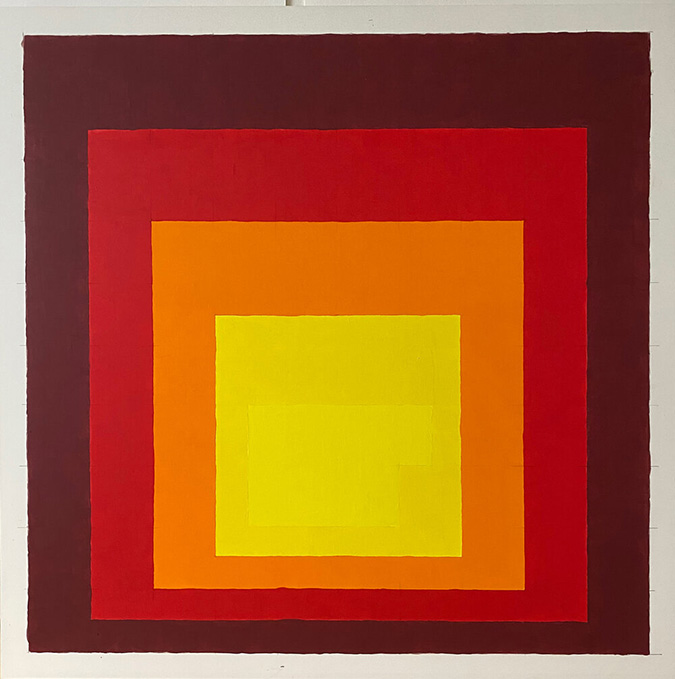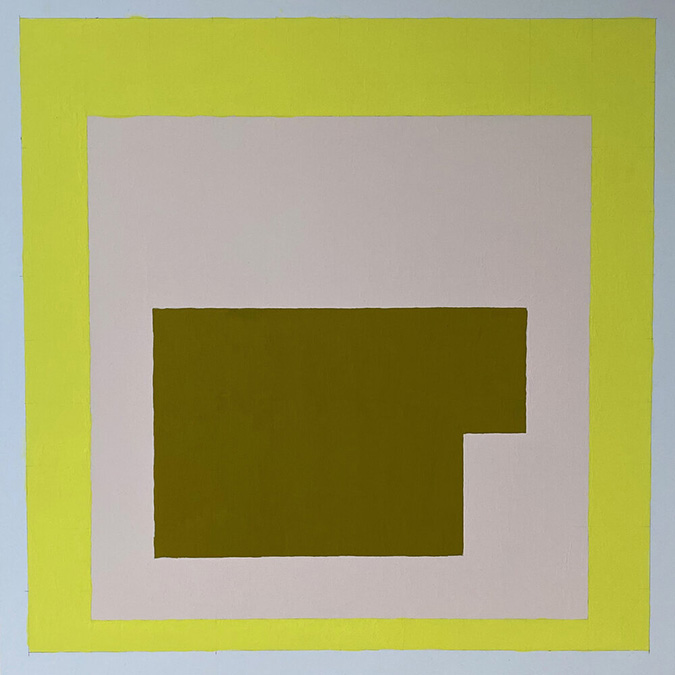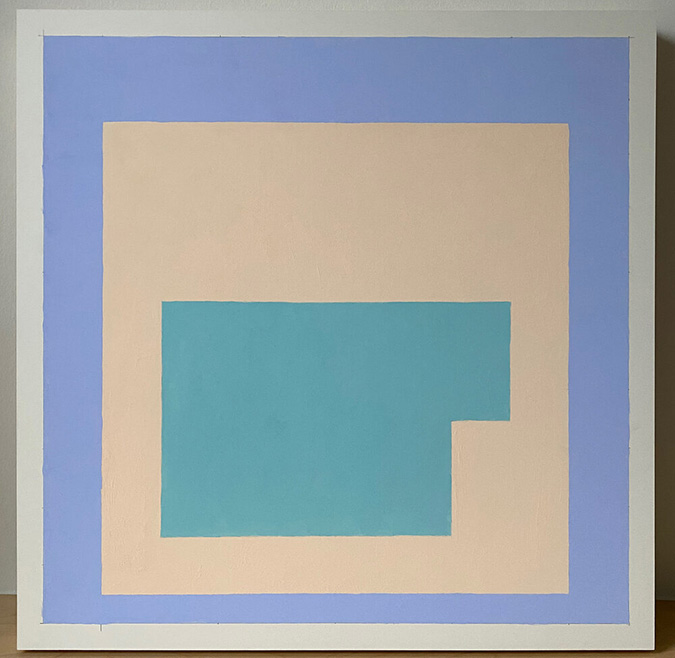Steve Locke
This work comes out of my direct engagement with color theory, portraiture and memory. The experience of working on Three Deliberate Grays for Freddie and the Auction Block Memorial have lead me into a new direction in painting. I am thinking about how modernist idioms can and do contain a racial history.
The work posits that the basic Modernist form is indeed the slave auction block. With the discovery of that form, all the other forms became possible.
In Homage to the Auction Block, I want to convey a sense of mapping and surveying into each painting. As such, each of these works retain some residue of their creation and conception. In the beginning, I used tape to get clean edges but my research into the work of Josef Albers lead me to abandon a taped line for a painted one. It gives the paintings a sense of humanity necessary to their conceptual underpinnings.
The application of flat color, the use of the grid, and the reliance on “primary structures” have art historical meanings central to Western Modernism-and its notion that form could be separated from its content. The works retain some residue of their and conception with guided and gridlines at times visible in the hand painted surface. Proportion and chromatic relationships are explored to varying visual effect. The use of the “auction block” motif literally organizes these modernist relations around the central symbol of chattel slavery in the Americas. The work reframes the work of modernism around the shape that made it possible.
My continued exploration of Josef Albers and his impact as a theorist, educator, and artist is a catalyst and an affirmation.

Homage to the Auction Block #80 (and shine), 24 x 24 inches, Acrylic on Panel, 2020.
“My teacher told my mom that she should encourage me to go into art because I could be the ‘first black artist,’ ” Gaines remembers with a chuckle. “Of course, there was already a rich black history in art, but nobody knew it because it wasn’t taught.”
Carolina A. Miranda
“How the dense grids of artist Charles Gaines took the ego out of art”
Los Angeles Times, 3 March 2015

Homage to the Auction Block #81 (lodestar), 24 x 24 inches, Acrylic on Panel, 2021.
“You know, if you were at a party and Greenberg was there with his people in the corner talking, when you went over, they would stop. They wouldn’t talk to you. Maybe I was also shy. So I just kind of watched. I don’t know if I was happy about it but that’s what I could do. When you’re young, you wonder, What is this art world and how do I fit in?”
Stanley Whitney
“Stanley Whitney by David Reed”
BOMB Magazine interview, 1 April 2013

Homage to the Auction Block #69, 24 x 24 inches, Acrylic on Panel, 2020.
“As I became more involved in the making of paintings, I realised that one of the main ingredients in making paintings was colour and geometry. And in New York I found ways of proceeding to deepen my investigations in that area. New York was very much the place where it was all happening.”
Frank Bowling
From figuration to abstraction, Tate Interview, 19 April 2012

Homage to the Auction Block #68, 24 x 24 inches, Acrylic on Panel, 2020.
In my opinion Black art is a misnomer. There are black artists and they, like all others, draw from their experiences to produce artistic expressions. If this expression is non representational, it is difficult or not impossible to tell whether the artist is white or non white. There can be no doubt however of the impact traditional African art has had on the world of modern art.
Alma Thomas
Alma Thomas papers, circa 1894-2001, Box 2, Folder 7: Autobiographical Writings, circa 1960s-circa 1970s

Homage to the Auction Block #72, 24 x 24 inches, Acrylic on Panel, 2021.
“We have thus, it may be seen, an honest, straightforward exhibit of a small nation of people, picturing their life and development without apology or gloss, and above all made by themselves.”
W.E.B. DuBois
“The American Negro at Paris.” The American Monthly Review of Reviews, vol.XXII, no.5 (November 1900): pp.575-577.

Homage to the Auction Block #72, 24 x 24 inches, Acrylic on Panel, 2020.
“It is a psychological error to believe that art stems from feeling only. Art comes from the conscious as well as from the subconscious—from both heart and mind. If art is order, it is intellectual order as well as initiative or instinctive order. Unfortunately there are people, teachers and students, afraid of the training of the conscious in art, afraid of the understandable in art. For those I should like to say that clear thinking will not and cannot interfere with genuine feeling; but it does interfere with prejudices, so often misinterpreted as feelings—and that’s all to the good. As in any other field of human endeavor, so it is worthwhile also in art to see and think clearly in teaching art, particularly basic design. I have tried to organize a method which provides a preparation for all visual art, a practical study of principles underlying and connecting all arts.”
Josef Albers
U.S. Specialist Report: Report on a Course in Basic Drawing, Design, and Color Given at the Hochschule für Gestaltung in Ulm, 1954
Steve Locke is a New York-based artist whose paintings, drawings, sculptures, and installations live at the intersections of portraiture, identity, and modernism. From the seductive nature of his paintings to the familiar but unreliable record of his photographs, he directs our gaze to help us look critically and unflinchingly at our shared history. Locke was born in 1963 in Cleveland, Ohio and raised in Detroit, Michigan. He received his M.F.A. in 2001 from Massachusetts College of Art and Design. In 2020, he was awarded the Guggenheim Fellowship from the John Simon Guggenheim Memorial Foundation. Solo exhibitions include the Isabella Stewart Gardner Museum, Institute of Contemporary Art, Boston, and Museum of Contemporary Art Detroit, among others. He has done projects with ForFreedoms, Kickstarter, the Boston Public Library, and P.S. Satellites/Prospect IV in New Orleans and has had gallery exhibitions with yours mine & ours, Samsøñ, LaMontagne Gallery, Gallery Kayafas, and Mendes Wood. He attended residencies with the City of Boston (2018), the Isabella Stewart Gardner Museum (2016), The MacDowell Colony (2015), and Skowhegan (2002). Locke is a recipient of grants from Pollock-Krasner Foundation, Louis Comfort Tiffany Foundation, and Art Matters Foundation. His work has been reviewed in Artforum, Art in America, The Boston Globe, and The New Yorker, and his writing has been published in Artforum as well as in museum catalogues. Locke is a Professor of Fine Arts at Pratt Institute in Brooklyn, NY.